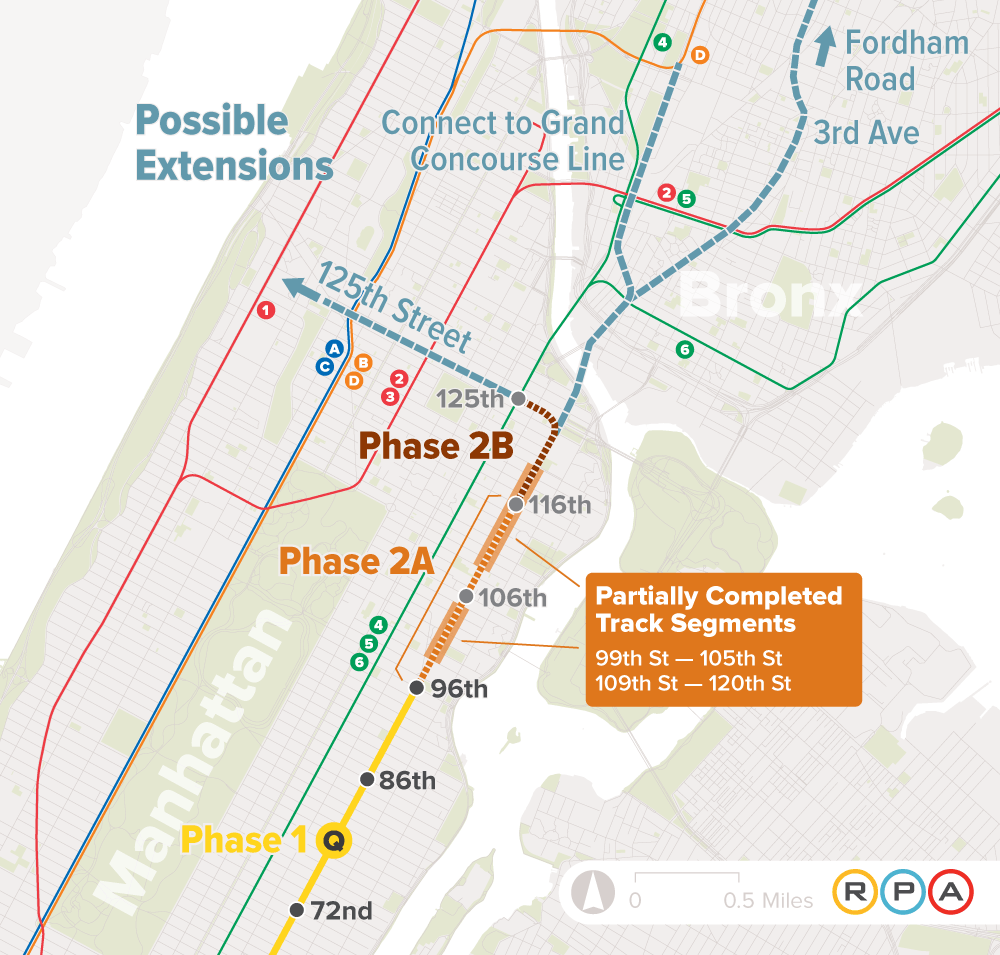The euphoria surrounding the opening of the first phase of the Second Avenue subway is understandable; we finally got the long-awaited line built, and now we will begin to see the enormous benefits that will flow from it. But don’t let the euphoria cloud the fact the job is hardly finished.
The original 1968 plan was for the line to extend south to the Battery and north well into the Bronx. The current MTA plan truncates that down to four construction phases, all within Manhattan - Phase II to 125th Street and two phases south to the southern tip of Manhattan. The MTA has announced they are pursuing the second phase and expect it to cost $6 billion for 1.7 miles – yes, $6 billion and 11 years – for three more stations, 106th Street and 116th Street on Second Avenue and at 125th Street and Lexington Avenue.
There are three things not right with that plan:
- It costs too much;
- It will take too long; and
- It may not be the best option for going north
It is well known that the cost of building subways in New York is higher than elsewhere. While some cost analyses ignore the difficulty of building subways in a highly built up area such as Manhattan’s Upper East Side, there is little doubt that costs are out of line.
The same is true with the delivery of these projects. The regulatory reviews alone can take up to a decade even before design and engineering commences. When construction does start it is slowed by extensive process and last minute changes to project specifications. These issues have to be addressed to ensure that Phase II is delivered as quickly and cost effectively as possible. One thing that would help: The MTA should more closely coordinate development between the city and state. There are also better methods of project delivery, something we’ll have more to say on in RPA’s report on capital construction costs due out this year.
The final issue is centered on where the Second Avenue subway should be extended northward to. The extension to 125th and Lexington is not a slam dunk. The station will have to be built below the existing Lexington Avenue station, a very expensive proposition likely requiring as much as half of the $6 billion extension cost. The 125th Street station also is fraught with difficult construction issues that could inflate the costs. Another option is to revive the original plan, with the subway heading straight north into the Bronx rather than turning under 125 Street and heading west. In the Bronx, it could serve the transit vacuum created when the Third Avenue El in the Bronx was abandoned in 1973 to Fordham Road or connect to the underutilized D Line that runs along the Grand Concourse.
Whether the subway goes to 125th Street or the Bronx, it would have tremendous benefits. If it is extended to 125th, it would connect with all the 4, 5, and 6 subway lines from the Bronx, further relieving the crowding on these Lexington Avenue lines, and it would offer a transfer to and from Metro-North lines, improving connections between city and suburb. Alternatively, if it is extended directly to the Bronx, it would still connect to the 4, 5, and 6 and serve areas long neglected and provide a boost to the budding renaissance in that borough and shorten trips into Manhattan.
What to do? Fortunately, there is a way to move forward before we have a definitive plan for what to do beyond 116th Street.

The Second Avenue subway can be extended to 116th Street, and the two stations in East Harlem can be built now. This one-mile stretch of subway is already partially built (from the aborted start in the 1970s), with a six-block segment completed between 99th and 105th Street and 10-block segment between 109th and 120th Street, which should make it far less expensive to build than Phase I.
But we’re not letting anybody off the hook. As we get started on the next phase, it’s vital that we make the cost and efficiency reforms that will make it more politically acceptable to build more transit for a thriving New York.

